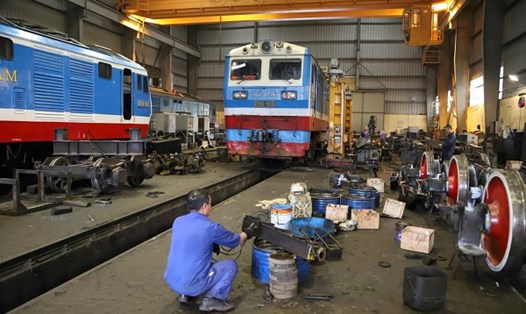Talking to the press about the current market share of the transport industry, Deputy Minister of Transport Nguyen Danh Huy said that, looking straight at reality, we are currently "using a butcher knife to kill a fly" when airlines are struggling to maintain flights under 500km (usually unprofitable).
Because for aviation, the time of take-off and landing is the time of consuming the most fuel. Flights under 500km are difficult to cover. However, to ensure current traffic, airlines still have to maintain short flights. Airlines are using profits from long flights to offset losses from short flights.
This situation is also happening when on the Hanoi - Ho Chi Minh City route there are still passenger transport buses running continuously by road.
In other words, air and road transport are having to take over passenger transport over distances where they are not advantageous.
The planning process of the transport sector has considered the potential and advantages of each method to build development scenarios.
Accordingly, for passenger transport, short distance (under 150km) is dominated by road; medium distance (150 - 800km), high-speed rail is completely dominant; long distance (over 800km) the market share mainly belongs to aviation and partly to high-speed rail.
Deputy Minister Nguyen Danh Huy emphasized: Investing in the construction of high-speed railways will contribute significantly to restructuring the market share of passenger transport between modes in a sustainable manner. At the same time, it will help reduce traffic accidents and other consequences such as reducing environmental emissions.
Thus, it is not that high-speed rail will eliminate air transport, but these two types of transport will complement each other.
Looking at the 5-industry Plan, from now until 2050, aviation will still lack “supply”. When there is a high-speed railway on the North-South axis, aviation will “give up” short routes for high-speed railway to promote its advantages.
At that time, aviation will restructure itself, infrastructure, airports will focus on exploiting long routes (over 800km) which is the advantage of aviation. Once again, we affirm that railways do not eliminate development opportunities for any sector.
According to data from the Ministry of Transport, the North-South corridor has the largest demand for freight and passenger transport.
The railway network planning for the period 2021 - 2030, with a vision to 2050, has planned to develop railway lines on the North - South corridor with 5 modes of transport.
With advantages in natural conditions, the ability to transport large volumes and low costs, according to statistics in 2023, sea and river transport will take on the majority of freight transport needs (107.7 billion tons, accounting for about 75.3%), roads will take on short distances, railways will take on medium and long distances for some types of goods, with a reasonable basic market share; for passenger transport, mainly undertaken by roads, railways and airlines, the market share is unbalanced (roads account for 62.9%, aviation accounts for 34.2%, railways account for 2.9% and are on a downward trend).
According to forecasts, by 2050, the demand for freight transport will be about 1.4-1.7 billion tons of goods and about 1.1-1.3 billion passengers. Of which, railway transport will handle about 18.2 million tons of goods (20.5 billion tons) and about 122.7 million passengers (101.3 billion passengers).
With this transportation demand, the existing railway after renovation and upgrading basically meets the demand for freight transport; however, the demand for passenger transport will be greatly lacking without a high-speed, large-volume transport method.
According to world experience, to solve the large demand for passenger transport, choosing to invest in high-speed railway lines is appropriate and effective.
Thus, investing in a high-speed railway from Hanoi to Ho Chi Minh City is necessary to address the shortage of passenger transport capacity, serve economic and social development, ensure national defense and security, and contribute to restructuring the transport market in a reasonable and sustainable direction.
After a long period of research, the Ministry of Transport has finalized the investment proposal for the North-South high-speed railway project as follows:
High-speed railway with a design speed of 350km/h; length of about 1,541km; double track, 1,435mm gauge, electrified; total investment of about 67.34 billion USD.
The project will be submitted to the National Assembly for approval of investment policy at the 8th Session in October 2024.
Bidding to select international consultants, conducting surveys, preparing Feasibility Study Reports in 2025-2026; implementing site clearance, bidding to select contractors and starting construction at the end of 2027.
Strive to complete construction of the entire route by 2035.













